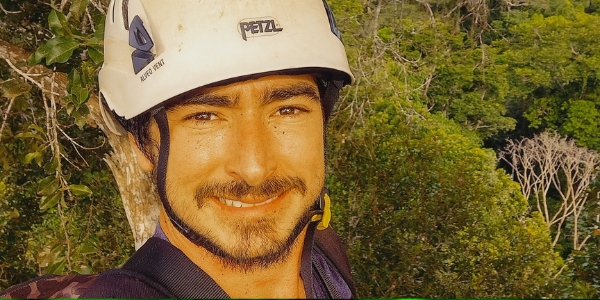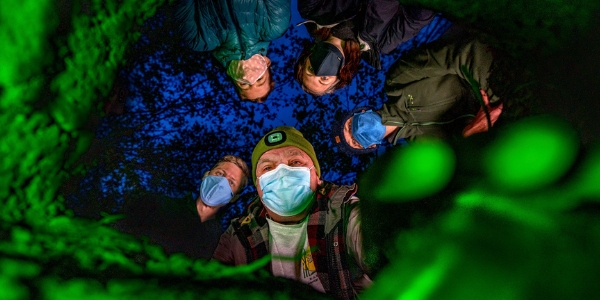Animals Shape-Shift in Response to a Warming World
At the South African nature preserve where Miya Warrington and colleagues study Cape ground squirrels (Xerus inauris), the maximum daily temperature has increased by about 2.5 °C in just 18 years. The animals have evolved a quiver of tactics to tolerate the region’s sweltering heat, says Warrington, a conservation ecologist at the University of Manitoba. Sprawling flat on the ground in a pose called splooting, for example, helps the animals shed heat from their less furry undersides. The squirrels also take shady respites under their bushy tails, which they curl above their heads like tiny parasols. When it’s really hot, the fossorial mammals retreat to their burrows to cool off. But Warrington warns that, even with all these options for keeping cool, “still they could be at the limits of their tolerance” due to such a rapid climactic shift.
That intense pressure could be why their bodies have begun to change shape, Warrington says. She found that, over the course of just under two decades, the squirrels’ already incredibly large hind feet, which may help dissipate heat, have grown relative to their body sizes by about 11 percent. Meanwhile, their spine lengths have become about 6 percent shorter.
And the Cape ground squirrel isn’t the only animal that appears to be shape-shifting in response to climate change. As scientists accumulate more evidence that many species’ bodies are undergoing subtle changes over a relatively short period of time, it remains unclear whether their adaptations can keep ahead of spiking temperatures—and how close they may be to a breaking point.
In the late 1800s, two biologists proposed separate but related hypotheses that endotherms’ bodies varied by latitude due to temperature. Bergmann’s rule posits that animals living near the warmer tropics tend to develop smaller bodies, while Allen’s rule predicts that appendages become larger

across the same spatial gradient. In both cases, the two biologists (after whom the rules are named) proposed that thermal adaptations to dissipate heat governed these trends.
“When you’re a smaller individual, you have a larger surface area to volume ratio, which allows you to basically dissipate heat more readily,” says Casey Youngflesh, a quantitative ecologist in integrative biology at Michigan State University, who is an EEB Presidential Postdoctoral Fellow. While Bergmann’s rule considers variations in latitude, Youngflesh sought to determine whether bird body sizes shrank temporally as climate change has driven hotter weather in areas throughout North America.
Looking across 105 avian species’ entire ranges, he and his colleagues scoured bird banding data compiled by The Institute for Bird Populations and found significant body mass reductions in 80 species over three decades. The analysis included more than 250,000 birds and found that the mean decline in mass across all species was about 0.6 percent, with tree swallows (Tachycineta bicolor) registering the largest decline at about 2.8 percent.
While the absolute numbers may seem small, Youngflesh points out that most evolutionary changes span geologic timescales. “I think we have to remember that this is only a period of 30 years,” he says. “And so seeing these sorts of changes over such a rapid timescale—it’s a little shocking.”
Phred Benham, an ornithologist and evolutionary biologist who wasn’t involved in Youngflesh’s study, agrees. “The scale of [their] project is immense,” he says, adding that to record this change in so many species over such a short period “really suggests that there is something global affecting all these birds—and climate change is what makes sense.”
Benham evaluated four subspecies of California savannah sparrows (Passerculus sandwichensis) and found that, as Allen’s rule would predict, bill size was generally larger in populations that lived farther south in California. However, he found growing beak sizes attributable to warmer and dryer conditions associated with climate change in only the coastal subspecies, P. sandwichensis alaudinus. Populations of this subspecies that reside in high-salinity tidal marshes in the state’s interior, where there’s far less fresh water, saw their beak surface areas expand up to roughly 7 percent in 150 years.
He and his colleagues then estimated this increase in bill size could reduce daily water loss by as much as about 16 percent. “If it’s gotten hotter through time, the costs to keeping cool are probably greater in a water-limited environment,” Benham explains. Because of this hypothesis, he says it would be interesting to see whether Youngflesh’s analysis shows more pronounced body size reductions in arid locations compared to humid ones.
While Bergmann and Allen’s rules imply animals evolve changes in size over millennia to withstand latitudinal temperature gradients, another rule–the temperature-size rule—describes a type of phenotypic plasticity that occurs in most ectotherms. “In almost every insect that [scientists have] looked at this, when you crank up the temperature that the juveniles develop through, the adults are always smaller in body size,” says Michelle Tseng, an insect and aquatic ecologist at the University of British Columbia. According to the theory, that’s because warmth speeds developmental biochemical reactions and shortens the time it takes an ectotherm to mature, resulting in a smaller adult, Tseng says.
But when it comes to studying the real-world implications of these changes, scientists “often don't clearly distinguish between statistical significance and biological significance,” Tseng says. Sometimes this is because they simply don’t know the real-world implications of their findings, but also because statistical significance tends to matter more when publishing. However, Tseng wanted to bridge that gap by designing an experiment that investigated whether temperature-induced shrinking might affect butterflies’ pollinating behavior.
At the South African nature preserve where Miya Warrington and colleagues study Cape ground squirrels (Xerus inauris), the maximum daily temperature has increased by about 2.5 °C in just 18 years. The animals have evolved a quiver of tactics to tolerate the region’s sweltering heat, says Warrington, a conservation ecologist at the University of Manitoba. Sprawling flat on the ground in a pose called splooting, for example, helps the animals shed heat from their less furry undersides. The squirrels also take shady respites under their bushy tails, which they curl above their heads like tiny parasols. When it’s really hot, the fossorial mammals retreat to their burrows to cool off. But Warrington warns that, even with all these options for keeping cool, “still they could be at the limits of their tolerance” due to such a rapid climactic shift.
That intense pressure could be why their bodies have begun to change shape, Warrington says. She found that, over the course of just under two decades, the squirrels’ already incredibly large hind feet, which may help dissipate heat, have grown relative to their body sizes by about 11 percent. Meanwhile, their spine lengths have become about 6 percent shorter.
And the Cape ground squirrel isn’t the only animal that appears to be shape-shifting in response to climate change. As scientists accumulate more evidence that many species’ bodies are undergoing subtle changes over a relatively short period of time, it remains unclear whether their adaptations can keep ahead of spiking temperatures—and how close they may be to a breaking point.
In the late 1800s, two biologists proposed separate but related hypotheses that endotherms’ bodies varied by latitude due to temperature. Bergmann’s rule posits that animals living near the warmer tropics tend to develop smaller bodies, while Allen’s rule predicts that appendages become larger across the same spatial gradient. In both cases, the two biologists (after whom the rules are named) proposed that thermal adaptations to dissipate heat governed these trends.
Youngflesh’s study also finds that while absolute bird wing lengths tended to remain the same over time, they became relatively longer compared to the birds’ shrinking bodies. However, Youngflesh hypothesizes this increased “wingyness” has less to do with heat dissipation, as Allen’s rule might suggest, and more to do with seasonal migrations. “When populations tend to migrate farther, they tend to have longer wings,” he says, adding that this finding may reflect birds’ need to preserve their ability to fly long distances seasonally.
Benham evaluated four subspecies of California savannah sparrows (Passerculus sandwichensis) and found that, as Allen’s rule would predict, bill size was generally larger in populations that lived farther south in California. However, he found growing beak sizes attributable to warmer and dryer conditions associated with climate change in only the coastal subspecies, P. sandwichensis alaudinus. Populations of this subspecies that reside in high-salinity tidal marshes in the state’s interior, where there’s far less fresh water, saw their beak surface areas expand up to roughly 7 percent in 150 years.
He and his colleagues then estimated this increase in bill size could reduce daily water loss by as much as about 16 percent. “If it’s gotten hotter through time, the costs to keeping cool are probably greater in a water-limited environment,” Benham explains. Because of this hypothesis, he says it would be interesting to see whether Youngflesh’s analysis shows more pronounced body size reductions in arid locations compared to humid ones.
While Bergmann and Allen’s rules imply animals evolve changes in size over millennia to withstand latitudinal temperature gradients, another rule–the temperature-size rule—describes a type of phenotypic plasticity that occurs in most ectotherms. “In almost every insect that [scientists have] looked at this, when you crank up the temperature that the juveniles develop through, the adults are always smaller in body size,” says Michelle Tseng, an insect and aquatic ecologist at the University of British Columbia. According to the theory, that’s because warmth speeds developmental biochemical reactions and shortens the time it takes an ectotherm to mature, resulting in a smaller adult, Tseng says.
But when it comes to studying the real-world implications of these changes, scientists “often don't clearly distinguish between statistical significance and biological significance,” Tseng says. Sometimes this is because they simply don’t know the real-world implications of their findings, but also because statistical significance tends to matter more when publishing. However, Tseng wanted to bridge that gap by designing an experiment that investigated whether temperature-induced shrinking might affect butterflies’ pollinating behavior.
“Those pollinator interactions are super important” for biodiversity, she says, because plants rely on pollinators to mix genes. Yet, “we don’t know very much at all about how insect body size affects . . . these plant-insect interactions.” To do that, she and her colleagues first investigated how climate change may affect the body and wing sizes of cabbage white butterflies (Pieris rapae). Tseng waited for the insects to lay eggs on the leaves of kale she grew in pots outside her home, which she would gently knock off and bring to her lab.
After the eggs hatched, Tseng and colleagues put the larvae into incubators controlled at 18 °C, 24 °C, and 30 °C. The warmest-reared insects matured about twice as fast, had the lowest body masses and smallest wing areas, and flew at slower velocities compared to the coldest-reared butterflies.
To determine whether these morphological shifts were biologically significant, she and her colleagues collected the same butterflies from the wild, sorted them into size groups that corresponded to her lab-grown specimens, and analyzed how much pollen they had accumulated. The team used gelatin to collect pollen from the animals’ faces and proboscises so they could evaluate microscopically how much pollen the butterflies carried and from which plant species. They found that the smaller butterflies—those equivalent in size to the warmest-reared lab insects—carried less pollen from fewer types of plants. “That was important for us because it meant that this kind of funny experiment that we did in the lab might actually have real life consequences” in terms of biodiversity, says Tseng.
Meredith Johnson, an insect physiology graduate student at Arizona State University, found another pollinator that may be shrinking as a result of climate change. Reviewing data collected at a field site over a period of five decades, she and her colleagues saw declines in the widths of male digger bees’ (Centris pallida) heads, a proxy for body size. The males in this species are dimorphic, meaning they appear in two distinct forms. While all male body sizes decreased, the larger morphs’ head widths decreased the most—by about 8 percent. Though the consequence of this are unknown, Johnson says that if males continue to shrink, populations could dwindle over time because larger males tend to have more mating success.
Johnson’s hypotheses to explain the shrinking include higher temperatures during development and mismatched host-plant phenology. Though she and her study authors didn’t test their theories, the likeliest possibilities all relate to climate change. “I’m not sure what else it would be,” she says.
One thing that remains unclear is whether body size changes are due to plasticity or an accelerated version of evolution. Among the researchers with whom The Scientist spoke, none who had conducted multi-generational studies had evidence to say definitively. “My guess is, like most traits, there’s probably a little bit of both,” speculates Benham, and Tseng says a lot of research is currently being conducted to try to parse the extent to which plasticity and evolution each factor into these changes...
All of the researchers that The Scientist spoke with suggest that the loss of species unable to adapt quickly enough to climate change could cause similar rippling effects. Youngflesh points to evidence that 30 percent of migratory birds have disappeared in the last 50 years as a reason to study what may seem like small changes in body shapes: It gives scientists clues to which species may be in the most danger. As we learn more about how the natural world’s puzzle pieces fit together and how ecosystems are changing in response to climate change, he says, “maybe there’s something we can do about it.”
Read the full story in Science



